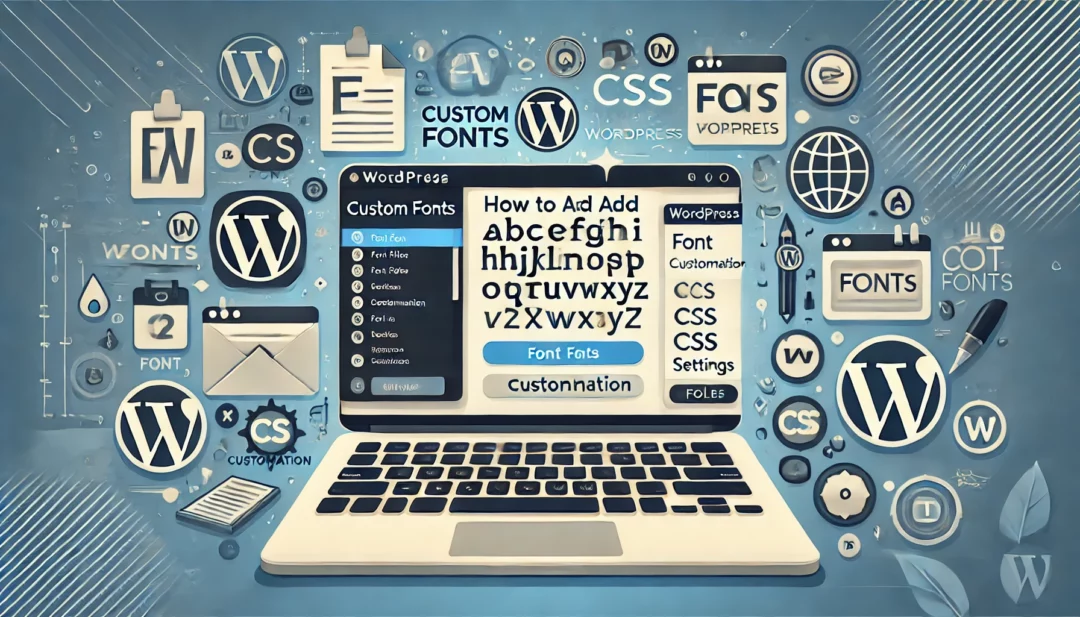
Customizing your WordPress site with unique fonts can instantly elevate its design and make it stand out. Whether you’re aiming for a sleek, modern look or a bold, creative vibe, adding custom fonts is easier than you might think. By incorporating the right typefaces, you can enhance readability and align your website’s style with your brand identity.
Why Custom Fonts Matter For Your WordPress Site
Custom fonts elevate your website design by improving its uniqueness and visual appeal. A distinct typeface captures user attention, reinforcing brand identity and credibility. For instance, a technology website benefits from sleek modern fonts, while handwritten styles suit creative portfolios.
Custom fonts enhance readability, ensuring users can easily engage with your content. Readable fonts reduce bounce rates and increase session durations. Sans-serif fonts, such as Open Sans, work well for large amounts of text, while serif fonts like Georgia add elegance to titles.
Incorporating custom fonts optimizes your site’s user experience. A poorly chosen default font can misalign with your message, damaging usability. Tailoring fonts ensures they align with colors, layouts, and overall design.
Methods To Add Custom Fonts To WordPress
Adding custom fonts to your WordPress site improves its aesthetics and reinforces your brand identity. Whether you prefer using plugins or coding manually, the process is straightforward. Below are the primary methods to achieve this.
Using A WordPress Plugin
Plugins simplify the process of adding custom fonts, especially for non-developers.
- Choose a Plugin: Install popular plugins like Use Any Font or Font Organizer from the WordPress Plugin Directory.
- Install and Activate: Navigate to your WordPress Dashboard, select Plugins, click Add New, search for the plugin, and activate it.
- Upload the Font Files: Access the plugin’s settings, upload your font file (in formats like .ttf or .woff), and assign it to specific sections of your website, such as titles or body text.
- Test the Font: Check your site to ensure the newly added font is applied correctly.
Using a plugin avoids manual coding and is ideal for beginners or those with limited technical expertise.
Adding Fonts Manually Through CSS
Manually adding fonts gives you granular control over design but requires basic coding knowledge.
- Upload Font Files: Use the Media Library or FTP client to upload font files to a folder in your theme directory.
- Declare Fonts in CSS: Open the style.css file and define font-face rules. For example:
@font-face {
font-family: 'CustomFont';
src: url('path-to-your-font/customfont.woff') format('woff');
}
- Apply Fonts to Elements: Use CSS selectors like
bodyorh1to apply the custom font:
body {
font-family: 'CustomFont', sans-serif;
}
- Save and Test: Save the CSS changes and reload your site to confirm the new font appears correctly.
Errors in CSS declarations or file paths are common pitfalls, so double-check entries.
Embedding Google Fonts
Google Fonts are free and easy to integrate into WordPress sites.
- Visit Google Fonts Library: Select a font from fonts.google.com and copy its embed code.
- Add Code to Header: Paste the provided
<link>tag into your theme’s header.php file before the closing</head>tag or use a plugin like Insert Headers and Footers to add it. - Define CSS Rules: Use your style.css file to apply the font, similar to the manual method:
h1 {
font-family: 'Roboto', sans-serif;
}
- Check Implementation: Refresh your site’s frontend to confirm the Google Font is applied.
Google Fonts offer a wide selection with no additional costs, making it popular for web designers.
Using Adobe Fonts (Typekit)
Adobe Fonts provides premium typefaces for creating distinctive web designs.
- Access Adobe Fonts: Log in to your Adobe account, select a font, and generate the embed code for your website in the Web Projects section.
- Insert Code in Header: Add the embed code to your header.php file or use a plugin to manage header scripts.
- Integrate in CSS: Modify the style.css file to assign the Adobe Font to different elements, just as you would with Google Fonts:
p {
font-family: 'Minion Pro', serif;
}
- Preview Changes: Open your website to verify that the fonts display as expected.
Adobe Fonts offers high-quality, professional typefaces but requires a subscription.
Best Practices For Adding Custom Fonts
Adding custom fonts to your WordPress site improves aesthetics and strengthens your brand identity. Following best practices ensures a seamless implementation while maintaining site functionality and user experience.
Ensure Site Performance Is Not Affected
Custom fonts can impact site performance if not managed properly. Use lightweight font files like WOFF2 for faster loading. Limit the number of fonts and styles to reduce HTTP requests. For example, instead of loading an entire family, select only the weights and styles you’ll use. Utilize Font-display: swap in CSS to display text while fonts load, preventing blank text or layout shifts. Compress font files with tools like Font Squirrel to lower file sizes.
Verify Browser And Device Compatibility
Some browsers and devices may not support all font formats. Include multiple font formats like WOFF, WOFF2, and TTF in your CSS @font-face rule to ensure compatibility. Test your website on different browsers (e.g., Chrome, Firefox, and Safari) and devices (e.g., desktops, tablets, and smartphones). Use services like BrowserStack to simulate environments and catch potential issues. Always provide a fallback font in your CSS to maintain readability if your custom font fails to load.
Keep Readability In Mind
Select fonts that align with your design while ensuring readability. Avoid using overly decorative or complex fonts for body text. Use clear, legible fonts like sans-serif for text-heavy sections and serif or display fonts for headings. Maintain a sufficient font size (e.g., 16px or larger for paragraphs) and adjust line height for improved readability. Test your font choices against various background colors to ensure contrast meets WCAG standards for accessibility. Choose fonts intentionally, balancing visual appeal with user experience.
Troubleshooting Common Issues
Adding custom fonts to WordPress can sometimes lead to challenges. Here are solutions to two common issues users face.
Fonts Not Displaying Correctly
Ensure proper installation by verifying font file compatibility and links. Unsupported formats, like TTF without fallbacks (e.g., WOFF2), can prevent font rendering.
- Check File Paths: Verify that file paths in the CSS are accurate and match the uploaded font directory. Wrong paths lead to loading errors.
- Include Multiple Formats: Add font files in at least WOFF, WOFF2, and TTF formats to enhance browser compatibility.
- Syntax Review: Ensure
@font-facerules in your stylesheet include properties likefont-family,src, andfont-weight, with semicolons accurately placed. - Clear Cache: Browsers often cache incorrect configurations. Clear the cache or test in incognito mode to confirm fixes.
For example, a rule might look like this in your CSS:
@font-face {
font-family: 'CustomFont';
src: url('fonts/CustomFont.woff2') format('woff2'),
url('fonts/CustomFont.woff') format('woff');
font-weight: normal;
font-style: normal;
}
Slow Page Load Times
Custom fonts can slow down your site when not optimized. Implement tools and strategies to reduce this impact.
- Optimize Font Files: Use font subsets for languages or required characters only. Full character sets increase file size unnecessarily.
- Use Modern Formats: Prioritize WOFF2 format over older formats for smaller file sizes and faster loading.
- Enable Font Caching: Add caching headers to encourage browsers to reuse downloaded fonts, reducing future load times.
- Limit Usage: Avoid applying multiple fonts or excessive styles (e.g., bold, italic). Each variation increases HTTP requests.
- Leverage CSS Properties: Use
font-display: swapto ensure the text remains visible during font loading, reducing layout shifts.
For example, include the font-display property like so:
@font-face {
font-family: 'CustomFont';
src: url('fonts/CustomFont.woff2') format('woff2');
font-display: swap;
}
Test performance regularly using tools like Google PageSpeed Insights to identify areas of improvement.
Conclusion
Custom fonts are a powerful way to make your WordPress site stand out while aligning it with your brand’s identity. By carefully selecting and implementing fonts, you can create a visually appealing and user-friendly experience that leaves a lasting impression on your audience.
Whether you choose plugins for simplicity or manual coding for greater control, the right approach depends on your needs and technical skills. Don’t forget to prioritize performance, readability, and accessibility to ensure your site remains fast and engaging.
With the right techniques and best practices, you’ll transform your website’s typography into a key element of its design and functionality. Take the time to experiment and refine your font choices—you’ll elevate your website’s style and credibility in no time.
Frequently Asked Questions
Why should I use custom fonts on my WordPress site?
Custom fonts enhance your website’s design, improve readability, and help align its style with your brand identity. They make your site more distinctive, appealing, and professional, attracting users and reinforcing credibility.
What types of fonts work best for different websites?
Modern fonts are ideal for technology websites, while handwritten or creative styles suit portfolios. Sans-serif fonts like Open Sans work well for body text, while serif fonts like Georgia are great for headings. Always prioritize readability and match the font with your brand tone.
How can I add custom fonts to WordPress?
You can use methods like plugins, manual coding with CSS, Google Fonts, or Adobe Fonts (Typekit). Plugins are beginner-friendly, while coding is better for developers needing more control.
Are custom fonts compatible with all browsers and devices?
Not all fonts are compatible. To ensure compatibility, include multiple font formats (WOFF2, TTF, etc.) and test your site on different browsers and devices.
How can I maintain website performance while using custom fonts?
Use lightweight font files, limit the number of fonts, and utilize CSS properties like font-display: swap to prevent layout shifts. Also, prioritize optimization, caching, and subsets.
What should I do if custom fonts don’t display correctly?
Ensure fonts are properly installed, file paths are correct, and the syntax in your CSS is accurate. Include multiple font formats and clear your browser cache to resolve display issues.
Do custom fonts affect page loading speed?
Yes, they can. To reduce the impact, use optimized font formats like WOFF2, implement caching, and load only necessary font styles. Combined, these strategies maintain fast loading times.
Can I use free fonts on WordPress sites?
Yes, free fonts like Google Fonts can be easily integrated and offer a wide range of styles. They are a great asset for beginners or sites with limited budgets.
Are premium font services like Adobe Fonts worth it?
Adobe Fonts provides high-quality, unique typefaces and is ideal for businesses seeking distinctive branding. However, it requires a subscription, so it’s best suited for those with a dedicated design budget.
How do custom fonts improve user experience?
Custom fonts enhance readability, improve aesthetics, and convey the right tone, ensuring visitors stay longer. Properly chosen fonts reduce bounce rates and amplify engagement with your content.






